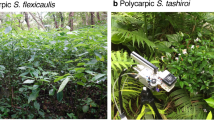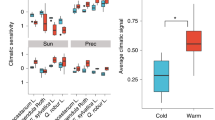Abstract
The widespread appearance of megaphyll leaves, with their branched veins and planate form, did not occur until the close of the Devonian period at about 360 Myr ago. This happened about 40 Myr after simple leafless vascular plants first colonized the land in the Late Silurian/Early Devonian1,2, but the reason for the slow emergence of this common feature of present-day plants is presently unresolved. Here we show, in a series of quantitative analyses using fossil leaf characters and biophysical principles, that the delay was causally linked with a 90% drop in atmospheric during the Late Palaeozoic era3,4. In contrast to simulations for a typical Early Devonian land plant, possessing few stomata5 on leafless stems, those for a planate leaf with the same stomatal characteristics indicate that it would have suffered lethal overheating, because of greater interception of solar energy and low transpiration. When planate leaves first appeared in the Late Devonian and subsequently diversified in the Carboniferous period, they possessed substantially higher stomatal densities6. This observation is consistent with the effects of the on stomatal development7 and suggests that the evolution of planate leaves could only have occurred after an increase in stomatal density, allowing higher transpiration rates that were sufficient to maintain cool and viable leaf temperatures.
This is a preview of subscription content, access via your institution
Access options
Subscribe to this journal
Receive 51 print issues and online access
$199.00 per year
only $3.90 per issue
Buy this article
- Purchase on Springer Link
- Instant access to full article PDF
Prices may be subject to local taxes which are calculated during checkout



Similar content being viewed by others
References
Gensel, P. G. & Andrews, H. N. Plant Life in the Devonian (Praeger Scientific, New York, 1984).
Kenrick, P. & Crane, P. R. The origin and early evolution of plants on land. Nature 389, 33–39 (1997).
Berner, R. A. GEOCARBII: a revised model of atmospheric CO2 over Phanerozoic time. Am. J. Sci. 294, 56–91 (1994).
Mora, C. I., Driese, S. G. & Colarusso, L. A. Middle to late Paleozoic atmospheric CO2 levels from soil carbonate and organic matter. Science 271, 1105–1107 (1996).
Edwards, D. Climate signals in Palaeozoic land plants. Phil. Trans. R. Soc. 353, 141–157 (1998).
McElwain, J. C. & Chaloner, W. G. Stomatal density and index of fossil plants track atmospheric carbon dioxide in the Palaeozoic. Ann. Bot. 76, 389–395 (1995).
Woodward, F. I. Stomatal numbers are sensitive to CO2 increases from pre-industrial levels. Nature 327, 617–618 (1987).
Chaloner, W. G. & Hemsley, A. R. in Pollen and Spores (eds Blackmore, S. & Barnes, S. H.) 151–167 (Clarendon, Oxford, 1991).
Zimmermann, W. Die Phylogenie der Pflanzen (Jena, Fischer, 1979).
Chaloner, W. G. & Sheerin, A. in The Devonian System (eds House, M. R., Scrutton, C. T. & Bassett, M. G.) 145–161 (Palaeontological Society Special Paper in Palaeontology, no. 23, 1979).
Hao, S. G. & Beck, C. B. Further observations on Eophyllophyton bellum from the lower Devonian (Siegenian) of Yunnan, China. Palaeontographica B 230, 27–47 (1993).
Larcher, W. in Ecophysiology of Photosynthesis (eds Schultze, E. D. & Caldwell, M. M.) 261–277 (Springer, Berlin, 1994).
Schulte, P. J., Gibson, A. C. & Nobel, P. S. Xylem anatomy and hydraulic conductance of Psilotum nudum. Am. J. Bot. 74, 1438–1445 (1987).
Berner, R. A. et al. Isotope fractionation and atmospheric oxygen: implications for Phanerozoic O2 evolution. Science 287, 1630–1633 (2000).
Beerling, D. J. et al. The influence of Carboniferous palaeo-atmospheres on plant function: an experimental and modelling assessment. Phil. Trans. R. Soc. 353, 131–140 (1998).
Farquhar, G. D., Ehleringer, J. R. & Hubrick, K. T. Carbon isotope discrimination and photosynthesis. Ann. Rev. Plant Physiol. Plant Mol. Biol. 40, 503–537 (1989).
Beerling, D. J. & Chaloner, W. G. Evolutionary responses of stomatal density to global CO2 change. Biol. J. Linn. Soc. 48, 343–353 (1993).
Nobel, P. S. Physicochemical and Environmental Physiology (Academic, San Diego, 1991).
Gensel, P. G. A new lower Devonian plant and the early evolution of leaves. Nature 309, 785–787 (1984).
Knoll, A. H. et al. Character diversification and patterns of evolution in early vascular plants for use in dynamic vegetation models. Paleobiology 10, 34–47 (1984).
Algeo, T. J. & Scheckler, S. E. Terrestrial-marine teleconnections in the Devonian: links between the evolution of land plants, weathering processes and marine anoxic events. Phil. Trans. R. Soc. 353, 113–130 (1998).
Beerling, D. J. & Woodward, F. I. Changes in land plant function over the Phanerozoic: reconstructions based on the fossil record. Bot. J. Linn. Soc. 124, 137–153 (1997).
Farquhar, G. D., Von Caemmerer, S. & Berry, J. A. A biochemical model of photosynthetic CO2 assimilation in leaves of C3 species. Planta 149, 78–90 (1980).
Von Caemmerer, S. & Farquhar, G. D. Some relationships between the biochemistry of photosynthesis and the gas exchange of leaves. Planta 153, 376–387 (1981).
Beerling, D. J. & Quick, W. P. A new technique for estimating rates of carboxylation and electron transport in leaves of C3 plants for use in dynamic vegetation models. Glob. Change Biol. 1, 289–294 (1995).
Bowes, G. Facing the inevitable–plants and increasing atmospheric CO2. Ann. Rev. Plant Physiol. Plant Mol. Biol. 44, 309–332 (1993).
Edwards, D., Kerp, H. & Hass, H. Stomata in early land plants: an anatomical and ecophysiological approach. J. Exp. Bot. 49, 309–332 (1993).
Niklas, K. J. The role of phyllotactic pattern as a “developmental constraint” on the interception of light by leaf surfaces. Evolution 42, 1–16 (1988).
Martinelli, L. A. et al. Stable carbon isotope ratio of tree leaves, boles and fine litter in a tropical forest in Rondonia, Brazil. Oecologia 114, 170–179 (1998).
Valdes, P. J. & Crowley, T. J. A climate model intercomparison for the Carboniferous. Palaeoclimates 2, 219–238 (1998).
Acknowledgements
We thank D. Edwards, J. A. Raven, F. I. Woodward and G. R. Upchurch for helpful comments and discussion on the manuscript. D.J.B. gratefully acknowledges funding through a Royal Society University Research Fellowship and the Natural Environment Research Council, UK.
Author information
Authors and Affiliations
Corresponding author
Rights and permissions
About this article
Cite this article
Beerling, D., Osborne, C. & Chaloner, W. Evolution of leaf-form in land plants linked to atmospheric CO2 decline in the Late Palaeozoic era. Nature 410, 352–354 (2001). https://doi.org/10.1038/35066546
Received:
Accepted:
Issue Date:
DOI: https://doi.org/10.1038/35066546
This article is cited by
-
Do all fungi have ancestors with endophytic lifestyles?
Fungal Diversity (2023)
-
Stomatal morphological variation contributes to global ecological adaptation and diversification of Brassica napus
Planta (2022)
-
Comparative transcriptomic analysis reveals conserved programmes underpinning organogenesis and reproduction in land plants
Nature Plants (2021)
-
Integrating stomatal physiology and morphology: evolution of stomatal control and development of future crops
Oecologia (2021)
-
ASYMMETRIC LEAVES1 and REVOLUTA are the key regulatory genes associated with pitcher development in Nepenthes khasiana
Scientific Reports (2019)
Comments
By submitting a comment you agree to abide by our Terms and Community Guidelines. If you find something abusive or that does not comply with our terms or guidelines please flag it as inappropriate.



